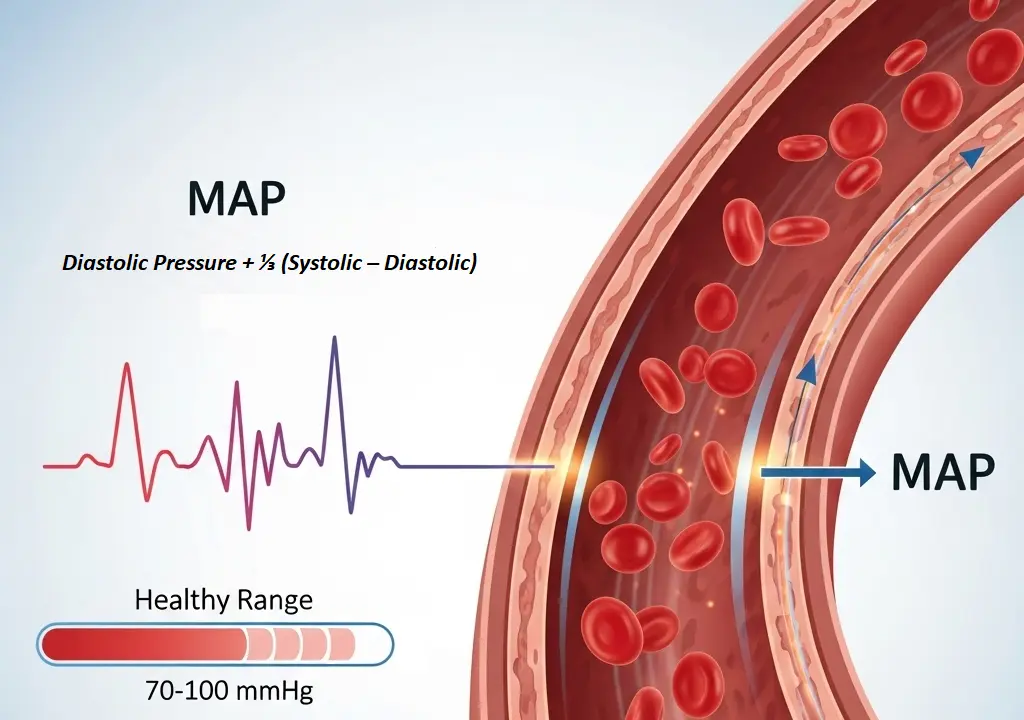Contents
Strength training is often discussed in terms of sets, reps, load, and recovery. While these elements are crucial, there is another factor that plays a key role in performance and long-term progress: mean arterial pressure (MAP). This measurement, which reflects the average blood pressure in a person’s arteries during one cardiac cycle, provides insight into how effectively blood delivers oxygen and nutrients to working muscles. For athletes, fitness enthusiasts, and anyone serious about training, understanding MAP can improve safety, optimize workouts, and support recovery.
What Is Mean Arterial Pressure?
Mean arterial pressure represents the average force that blood exerts on artery walls during a heartbeat cycle. Unlike systolic and diastolic readings, which give single moments of pressure, MAP offers a more comprehensive measure of blood flow. It can be estimated with a simple formula:
MAP ≈ Diastolic Pressure + ⅓ (Systolic – Diastolic).
For example, if someone has a blood pressure of 120/80 mmHg, their MAP is roughly 93 mmHg. A MAP between 70 and 100 mmHg is typically considered healthy for most adults, ensuring tissues—including skeletal muscles—receive adequate perfusion.
Why MAP Matters for Strength Training
During strength training, muscles demand increased oxygen and nutrients to perform under resistance. MAP directly influences how efficiently this blood flow occurs. Too low, and muscles may not get the resources they need; too high, and the cardiovascular system is placed under unnecessary strain.
Key reasons MAP matters for lifters include:
- Muscle Performance: Adequate MAP ensures efficient delivery of glucose, oxygen, and amino acids to active muscle fibers.
- Recovery: Healthy circulation allows metabolic byproducts like lactate to be cleared more quickly, reducing soreness and fatigue.
- Safety: Excessively elevated MAP during heavy lifting can increase the risk of vascular strain, particularly in individuals with pre-existing cardiovascular issues.
MAP and the Acute Response to Lifting
When lifting heavy weights, blood pressure rises significantly, sometimes reaching two to three times resting levels. This acute increase boosts MAP temporarily, ensuring working muscles receive adequate blood supply under stress.
Factors influencing this response include:
- Breathing Technique: Holding the breath during a lift (Valsalva maneuver) increases intrathoracic pressure, spiking MAP dramatically. Controlled breathing can moderate this effect.
- Load Intensity: Higher weights and fewer reps cause sharper increases in MAP compared to moderate loads and higher reps.
- Rest Periods: Shorter rest times keep MAP elevated for longer, while longer rests allow it to return closer to baseline.
These responses are normal adaptations, but consistently training with very high pressures may stress the cardiovascular system.
MAP and Long-Term Adaptations
Regular strength training can influence MAP in both positive and negative ways, depending on
program design and lifestyle factors:
- Positive Adaptations: Moderate-intensity strength training combined with cardiovascular exercise may reduce resting MAP by improving arterial elasticity and cardiac efficiency.
- Negative Adaptations: Training with excessive load, poor recovery, or without adequate cardiovascular conditioning can contribute to chronically elevated blood pressure, raising MAP over time.
Balancing intensity and recovery is essential to ensure MAP supports rather than hinders performance.
Practical Ways to Manage MAP in Training
Athletes and fitness enthusiasts can take steps to keep MAP within healthy ranges while still pursuing strength goals. Key strategies include:
- Warm-Up Properly: Gradual cardiovascular warm-ups prepare blood vessels and the heart for higher demands.
- Practice Controlled Breathing: Exhaling during exertion helps prevent extreme pressure spikes.
- Avoid Overtraining: Adequate rest days prevent chronically high stress hormones, which can raise blood pressure.
- Incorporate Cardio Training: Aerobic exercise strengthens the heart and improves vascular health, helping regulate MAP.
- Monitor Hydration: Proper fluid balance supports blood volume and stable circulation.
- Track Progress Holistically: Don’t just monitor reps and weights—keep an eye on blood pressure trends as well.
MAP and Recovery
Recovery is as important as the workout itself. After training, MAP gradually returns to baseline, but recovery can be delayed by dehydration, poor sleep, or inadequate nutrition. Chronic fatigue, poor performance, and excessive soreness may all be linked to impaired circulation. Supporting MAP during recovery ensures that muscles repair efficiently and performance continues to improve.
Sleep quality, stretching, and active recovery methods like light cardio or mobility work all help maintain healthy blood flow. This, in turn, keeps MAP within a range that promotes healing.
The Role of Monitoring Tools
Modern athletes and fitness enthusiasts often use calculators and devices to track their health metrics. Just as one might use a body fat calculator or a heart rate monitor, tracking MAP offers valuable insight into cardiovascular health during training. Tools like a BP MAP calculator can help individuals estimate mean arterial pressure using simple systolic and diastolic readings, making it easier to keep an eye on long-term trends.
Who Should Pay Extra Attention to MAP?
While everyone can benefit from understanding MAP, certain groups should be especially mindful:
- Beginners: Those new to strength training may see sharper spikes in blood pressure during initial workouts.
- Older Adults: Age-related vascular changes can affect MAP, making monitoring more important. Individuals with Hypertension: People with high blood pressure should consult healthcare providers and track MAP during exercise.
- Athletes Training at High Intensities: Competitive lifters and athletes often push their cardiovascular systems to extremes.
By being aware of MAP, these individuals can adjust their programs for both performance and safety.
Bringing It All Together
Strength training is more than building muscle—it’s a systemic stressor that challenges both the muscular and cardiovascular systems. Mean arterial pressure provides a window into how effectively the body is adapting to these demands.
By understanding and monitoring MAP, athletes can:
- Improve performance by ensuring muscles receive adequate resources.
- Enhance recovery by supporting circulation and metabolic clearance.
- Protect long-term health by preventing chronic elevation of blood pressure.
Whether you’re a beginner or an advanced lifter, paying attention to MAP adds another layer of intelligence to your training program. Tools such as a BP MAP calculator make this process accessible, allowing you to track one of the most important, yet often overlooked, indicators of exercise readiness and safety.



